Vegetarian bibimbap bowls piled high with winter vegetables for a healthy dinner. To top it all off, add that essential runny egg so you’ve got a delicious yolk to stir through the mix. Gluten free and dairy free. Thank you to Australian Eggs for sponsoring this tasty post!
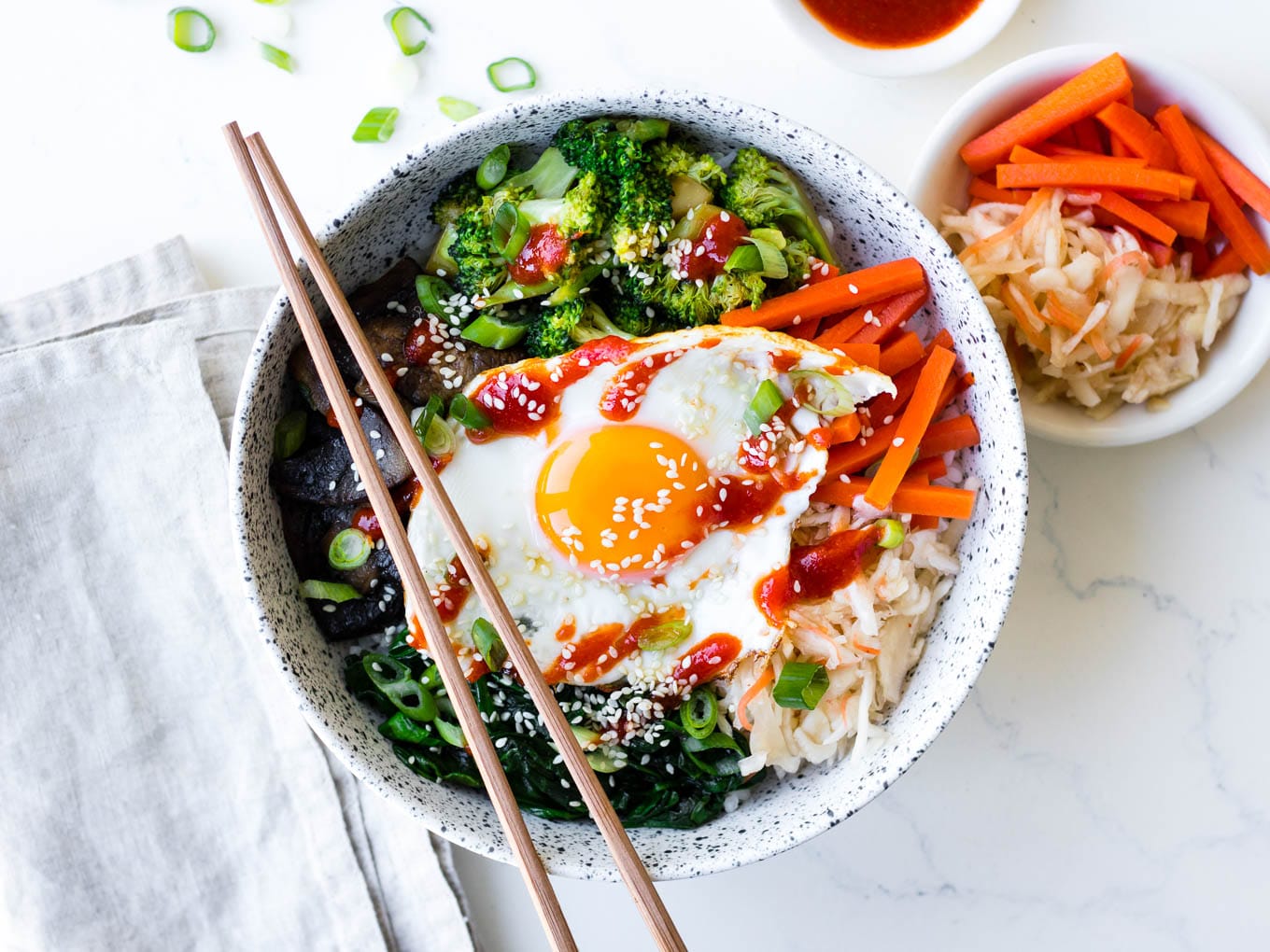
Guys, have I told you about my love for eggs? It runs deep. My fridge is only functional when I’ve got a carton of eggs in there – they are the basis for our weekend brekkies, I boil them up for my weekday lunchboxes, and they often end up as my dinner too. Easy, economical, accessible. They are my weekly staple, which is why I’m very excited to be sharing with you a series of recipes in partnership with Australian Eggs over the next month!
So let’s kick things off by making the humble fried egg into something a little fancier here. They’re the crowning glory on these vegetarian bibimbap bowls – the dish just wouldn’t be complete without it. It’s essential to have all that yolky goodness to stir through the dish, and bring all the ingredients together.
Okay – and you can definitely add TWO fried eggs to this dish if you want. More protein, right?!

If you’re not too familiar with bibimbap, it’s a traditional Korean dish that basically consists of rice topped with sautéed vegetables, meat, spicy sauce and quite often, a fried egg. As we’re making a vegetarian bibimbap here I’ve omitted the meat, of course! So in this vegetarian version you’ll find:
- rice (you can use any variety you like);
- pickled carrots (optional step! You can just use fresh carrots, don’t worry);
- veggies sautéed in tamari-garlic sauce;
- kimchi (or sauerkraut); and
- those fine yolky fried Australian eggs.
Regarding the kimchi – kimchi can often have fish and/or anchovy paste added to it, so it may not be vegetarian. You can swap this to a sauerkraut which should be totally vegetarian-friendly (but be sure to check the ingredients list when purchasing).
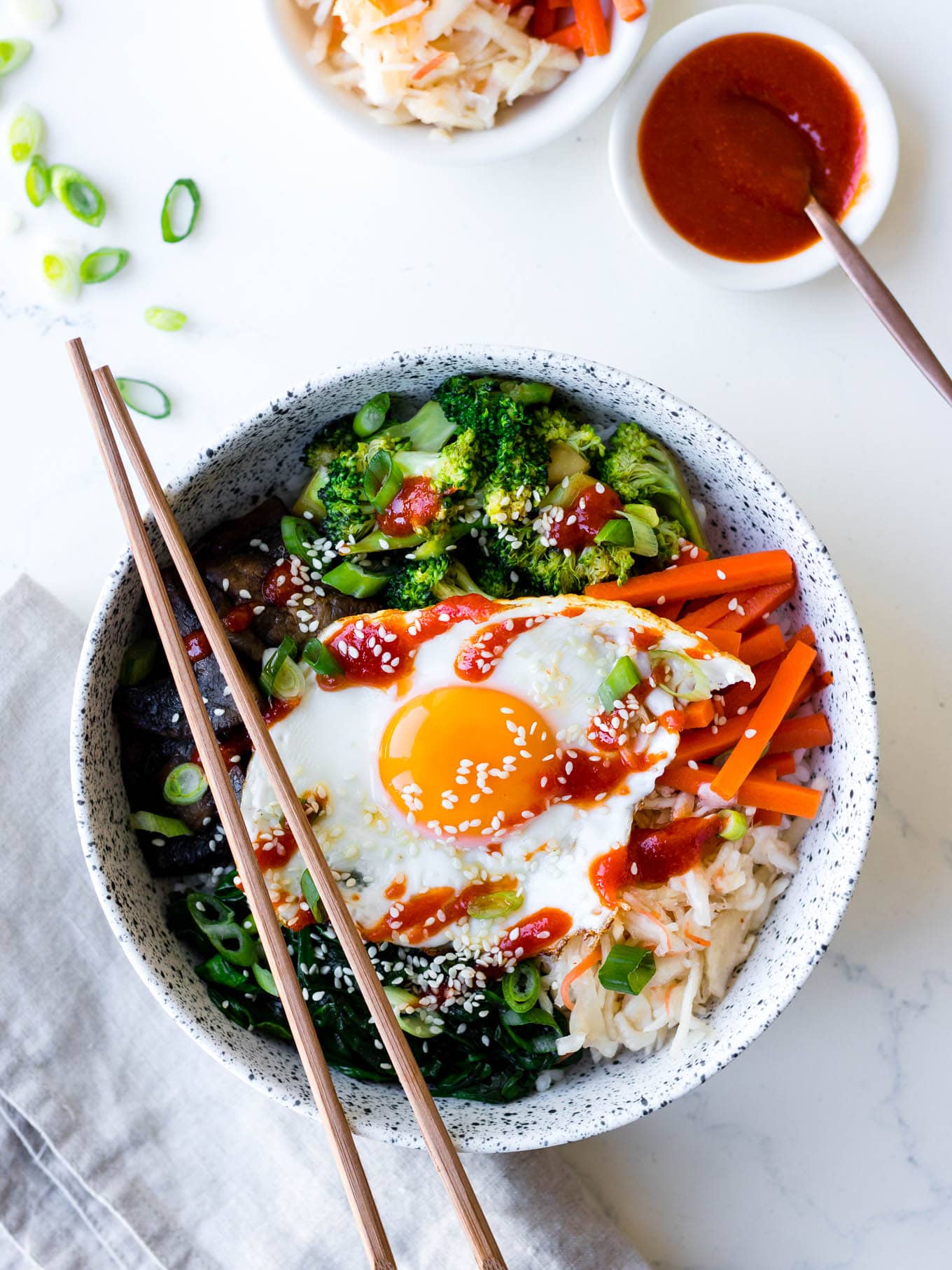
I’ve simplified the traditional bibimbap recipe here too by using sriracha sauce as the spicy sauce element. A traditional bibimbap uses Korean gochujang paste, which is a chilli-garlic paste. However, I totally appreciate that gochujang paste may not be the easiest thing to find, and trust me a little squeeze of the sriracha-based sauce I’ve substituted is enough to give these vegetarian bibimbap bowls a total flavour punch! You can find sriracha in the supermarket.
Now the final question… how do you eat a bibimbap?! Well my friend, this is where you come to truly appreciate the runny egg you placed on top. MIX IT UP! Arrange everything like a perfect rainbow in a bowl, and then get in there and mix all the elements together, stirring the runny egg yolk through. You’ll get a little bit of everything in each bite.
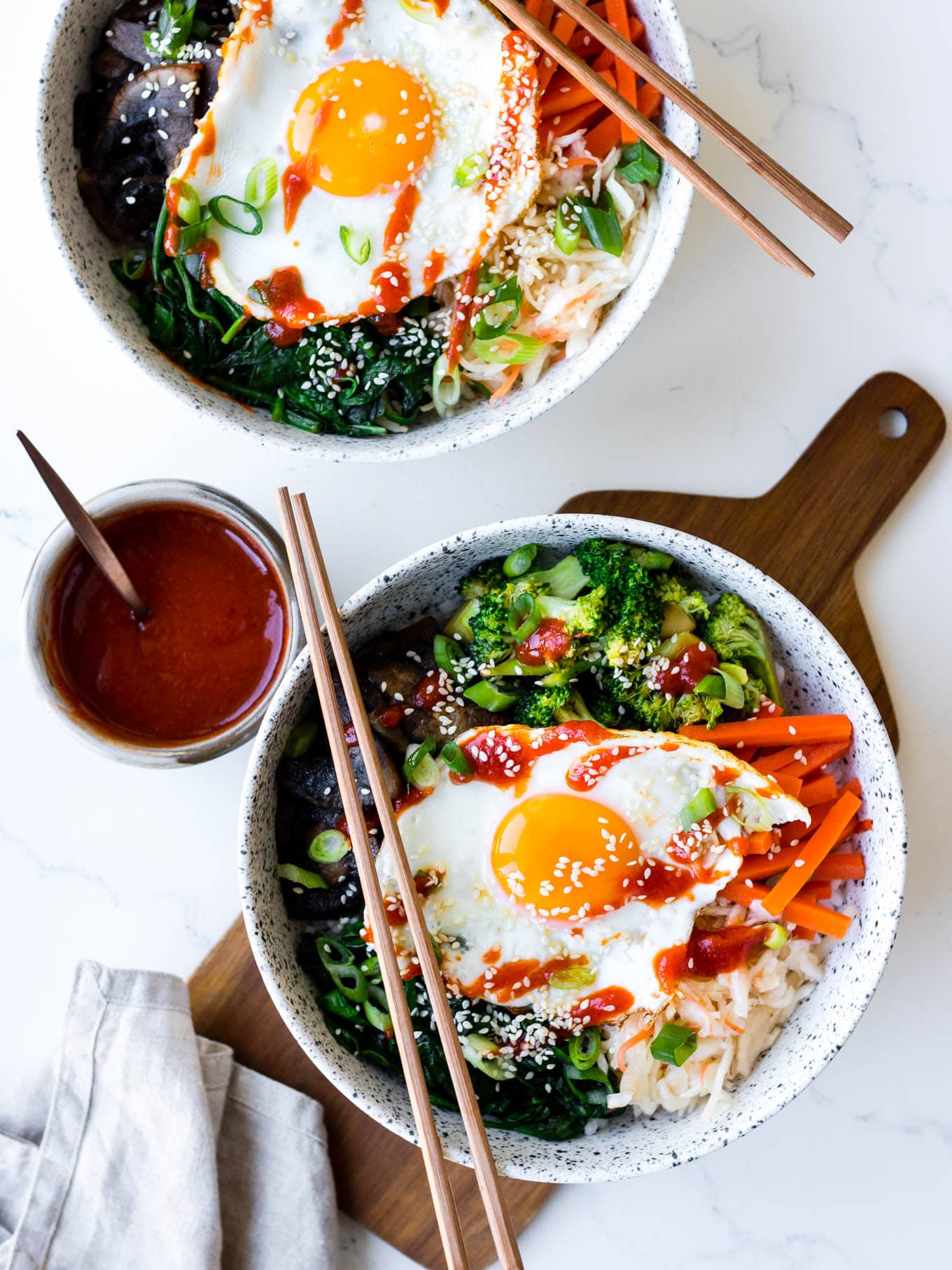
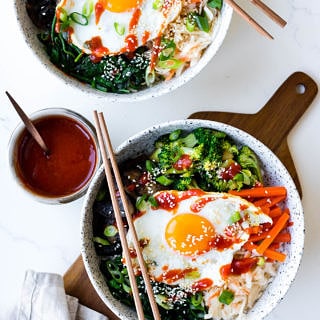
Vegetarian Bibimbap Bowls with Winter Veg
Ingredients
- 3/4 cup rice (any variety) measured uncooked
- 2-4 eggs - depending on whether you would like 1 or 2 eggs per bowl
- 2 cups broccoli chopped into small florets (160-190 grams)
- 2 ½ cups mushrooms sliced (170-200 grams)
- 1 medium-large carrot
- 4 big handfuls baby spinach
- 2 spring onions
- 1 tbsp sesame seeds
- 3 tbsp tamari or gluten free soy sauce
- 1 tbsp sesame oil
- 1 tsp garlic powder
- coconut, macadamia or olive oil for cooking
- salt and pepper
- kimchi or sauerkraut to serve
For pickling the carrot:
- 1/2 cup rice vinegar (can substitute apple cider vinegar)
- 1/2 cup water
- 2 tbsp honey or maple syrup
Bibimbap sauce:
- 3 tbsp sriracha sauce
- 1/2 tsp garlic powder
- 1 tbsp honey or maple syrup
- 1 tsp sesame oil
Instructions
- If you’d like to have pickled carrots, start this recipe a day or two before so the carrots have time to pickle. To make the pickle: cut the carrot into matchsticks. Combine vinegar, water and maple syrup in a saucepan and bring to the boil, allow to bubble for 1 minute then cool for 5 minutes. Pack the carrot sticks into a container/jar and pour over the liquid. Pop in the fridge.
- To start the bibimbap: prepare rice according to packet instructions. While the rice is cooking, you can start to cook the vegetables.
- Get your sauces ready: make the vegetable stir-fry sauce by combining the tamari/soy-sauce, 1 tablespoon sesame oil, 1 teaspoon garlic powder and 2 tablespoons of water, plus a little salt and pepper to taste. Make the bibimbap sauce by combining the sriracha, ½ teaspoon garlic powder, 1 tablespoon maple syrup and 1 teaspoon sesame oil.
- Take a fry pan and add a teaspoon of your chosen cooking oil. Add the broccoli to the pan, and sauté over a moderate heat for 3 minutes or until softened. As the broccoli is cooking, add 2 tbsp of the stir-fry sauce to the pan. Once the broccoli is done, slide it off onto a plate and set aside (you could put this in a very low-heat oven to keep warm).
- Repeat the stir-fry process for the sliced mushrooms and the spinach, cooking each until softened and splashing through some stir-fry sauce.
- Once the rice and all of the vegetables are cooked, arrange into two bowls. Add a serve of kimchi/sauerkraut and pickled carrot. Finally, fry up your eggs, keeping the yolks soft and runny. Slide them onto the top of the bowls.
- Garnish bowls with bibimbap sauce, chopped spring onion and sesame seeds. Enjoy!
Notes
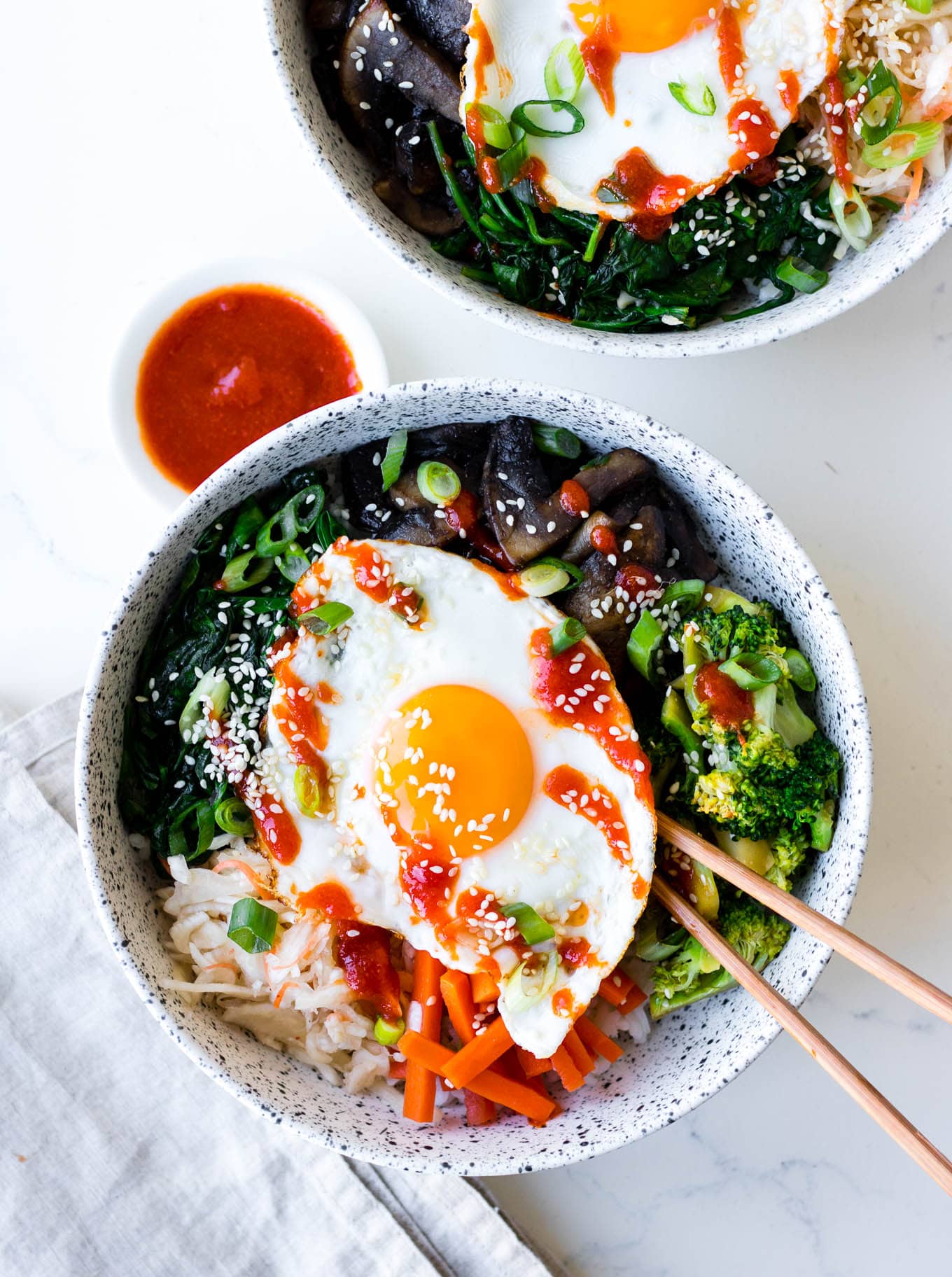


I make this all the time, and it is a taste explosion! Every time i take leftovers to work my colleagues comment on it and ask for the recipe. Straight forward and easy to make with whatever veges are in the fridge at the time. Its the sauces that make this pop!
Thank you SO much for this beautiful comment Latesha! I’m so happy to hear you love it 🙂
Made this last night and my tastebuds were blown – couldn’t believe how authentic it tasted. Definitely a new staple in this household.
Thank you so much for your lovely comment Ky, I’m so glad you enjoyed it 🙂
Wow, this dish looks amazing and I’m sure it tasks fabulous, reminds me of Indonesian Nasi Goreng but without any noodles. Cant wait to try this one for my family.
Thanks so much Samantha! I love a good nasi goreng too, both dishes are so full of flavour 🙂